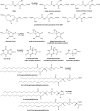Elucidating mechanisms of chlorine toxicity: reaction kinetics, thermodynamics, and physiological implications
- PMID: 20525917
- PMCID: PMC2951076
- DOI: 10.1152/ajplung.00077.2010
Elucidating mechanisms of chlorine toxicity: reaction kinetics, thermodynamics, and physiological implications
Abstract
Industrial and transport accidents, accidental releases during recreational swimming pool water treatment, household accidents due to mixing bleach with acidic cleaners, and, in recent years, usage of chlorine during war and in acts of terror, all contribute to the general and elevated state of alert with regard to chlorine gas. We here describe chemical and physical properties of Cl(2) that are relevant to its chemical reactivity with biological molecules, including water-soluble small-molecular-weight antioxidants, amino acid residues in proteins, and amino-phospholipids such as phosphatidylethanolamine and phosphatidylserine that are present in the lining fluid layers covering the airways and alveolar spaces. We further conduct a Cl(2) penetration analysis to assess how far Cl(2) can penetrate the surface of the lung before it reacts with water or biological substrate molecules. Our results strongly suggest that Cl(2) will predominantly react directly with biological molecules in the lung epithelial lining fluid, such as low-molecular-weight antioxidants, and that the hydrolysis of Cl(2) to HOCl (and HCl) can be important only when these biological molecules have been depleted by direct chemical reaction with Cl(2). The results from this theoretical analysis are then used for the assessment of the potential benefits of adjuvant antioxidant therapy in the mitigation of lung injury due to inhalation of Cl(2) and are compared with recent experimental results.
Figures


Similar articles
-
Mechanisms and modification of chlorine-induced lung injury in animals.Proc Am Thorac Soc. 2010 Jul;7(4):278-83. doi: 10.1513/pats.201001-009SM. Proc Am Thorac Soc. 2010. PMID: 20601632 Free PMC article. Review.
-
Targeted aerosolized delivery of ascorbate in the lungs of chlorine-exposed rats.J Aerosol Med Pulm Drug Deliv. 2012 Dec;25(6):333-41. doi: 10.1089/jamp.2011.0963. Epub 2012 Mar 6. J Aerosol Med Pulm Drug Deliv. 2012. PMID: 22393907 Free PMC article.
-
Mitigation of chlorine-induced lung injury by low-molecular-weight antioxidants.Am J Physiol Lung Cell Mol Physiol. 2008 Nov;295(5):L733-43. doi: 10.1152/ajplung.90240.2008. Epub 2008 Aug 15. Am J Physiol Lung Cell Mol Physiol. 2008. PMID: 18708632 Free PMC article.
-
Chlorine gas inhalation: human clinical evidence of toxicity and experience in animal models.Proc Am Thorac Soc. 2010 Jul;7(4):257-63. doi: 10.1513/pats.201001-008SM. Proc Am Thorac Soc. 2010. PMID: 20601629 Free PMC article. Review.
-
Chlorine: state of the art.Lung. 2005 May-Jun;183(3):151-67. doi: 10.1007/s00408-004-2530-3. Lung. 2005. PMID: 16078037 Review.
Cited by
-
Post-exposure antioxidant treatment in rats decreases airway hyperplasia and hyperreactivity due to chlorine inhalation.Am J Respir Cell Mol Biol. 2012 May;46(5):599-606. doi: 10.1165/rcmb.2011-0196OC. Epub 2011 Dec 8. Am J Respir Cell Mol Biol. 2012. PMID: 22162906 Free PMC article.
-
Respiratory syncytial virus infection increases chlorine-induced airway hyperresponsiveness.Am J Physiol Lung Cell Mol Physiol. 2015 Aug 1;309(3):L205-10. doi: 10.1152/ajplung.00159.2015. Epub 2015 Jun 12. Am J Physiol Lung Cell Mol Physiol. 2015. PMID: 26071553 Free PMC article.
-
Deviations from Haber's Law for multiple measures of acute lung injury in chlorine-exposed mice.Toxicol Sci. 2010 Dec;118(2):696-703. doi: 10.1093/toxsci/kfq264. Epub 2010 Sep 6. Toxicol Sci. 2010. PMID: 20819911 Free PMC article.
-
Halogen Inhalation-Induced Lung Injury and Acute Respiratory Distress Syndrome.Chin Med J (Engl). 2018 May 20;131(10):1214-1219. doi: 10.4103/0366-6999.231515. Chin Med J (Engl). 2018. PMID: 29722341 Free PMC article. Review.
-
Halogen-Induced Chemical Injury to the Mammalian Cardiopulmonary Systems.Physiology (Bethesda). 2021 Sep 1;36(5):272-291. doi: 10.1152/physiol.00004.2021. Physiology (Bethesda). 2021. PMID: 34431415 Free PMC article. Review.
References
-
- Agency For Toxic Substances and Disease Registry Draft Toxicological Profile for Chlorine. Agency for Toxic Substances and Disease Registry, 2007
-
- Andreozzi R, Caprio V, Ermellino I, Insola A, Tufano V. Ozone solubility in phosphate-buffered aqueous solutions: effect of temperature, tert-butyl alcohol, and pH. Indust Engineer Chem Res 35: 1467–1471, 1996
-
- Armesto XL, Canle M, Fernandez MI, Garcia MV, Santaballa JA. First steps in the oxidation of sulfur-containing amino acids by hypohalogenation: Very fast generation of intermediate sulfenyl halides and halosulfonium cations. Tetrahedron 56: 1103–1109, 2000
-
- Babu RV, Cardenas V, Sharma G. Acute respiratory distress syndrome from chlorine inhalation during a swimming pool accident: a case report and review of the literature. J Intensive Care Med 23: 275–280, 2008 - PubMed
Publication types
MeSH terms
Substances
Grants and funding
LinkOut - more resources
Full Text Sources
Other Literature Sources

